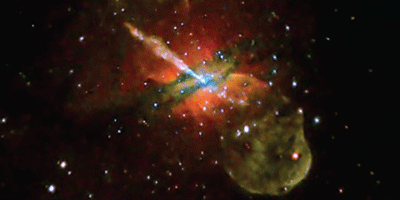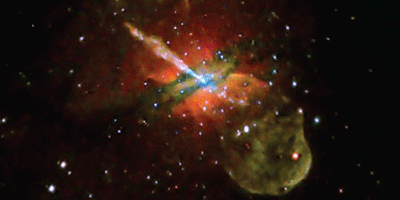Tabletop Particle Accelerator
Black holes and pulsars emit dense jets of particles that are made of electrons and positrons (the antiparticle of the electron). But many important and basic features of the jets remain unclear: What is their precise particle makeup? How much energy do they contain? How do the particles in the jets interact in the low-density environment of outerspace? The main difficulty in answering these questions is that astronomical systems can only be measured indirectly: the closest jet is almost miles away. As Gianluca Sarri from The Queen’s University of Belfast, Northern Ireland, and colleagues report in Physical Review Letters, a new tabletop method for generating electron-positron streams could bring measurements closer to home by enabling the scaled-down reproduction of matter-antimatter flows in the lab.
Sarri et al. used the University of Michigan’s powerful HERCULES petawatt laser to ionize an inert gas and produce a high-energy electron beam. By bombarding copper, tin, tantalum, and lead targets with this beam, they were able to form dense, narrow streams of high-energy electrons and positrons. The jets emerged in shorter duration, denser pulses than those generated in traditional large-scale ( size) particle accelerators.
The laser-based system, which is less than a meter in size, is able to simultaneously form jets and plasmas, something that cannot be done easily using other methods. This simple setup could therefore be used to directly probe the interaction between the jets and plasmas in well-controlled laboratory experiments. Such studies could provide answers to some of the fundamental questions about antimatter, astrophysical jets, and, ultimately, the physics of black holes and pulsars. – Katherine Thomas





